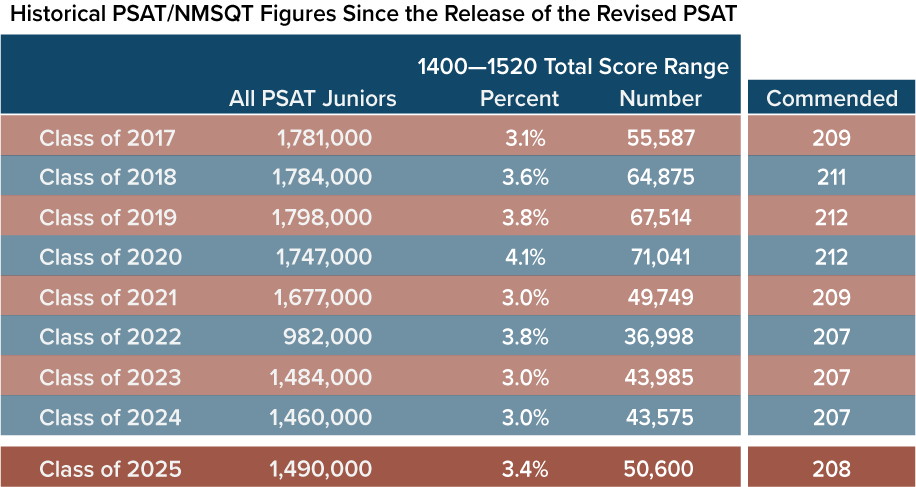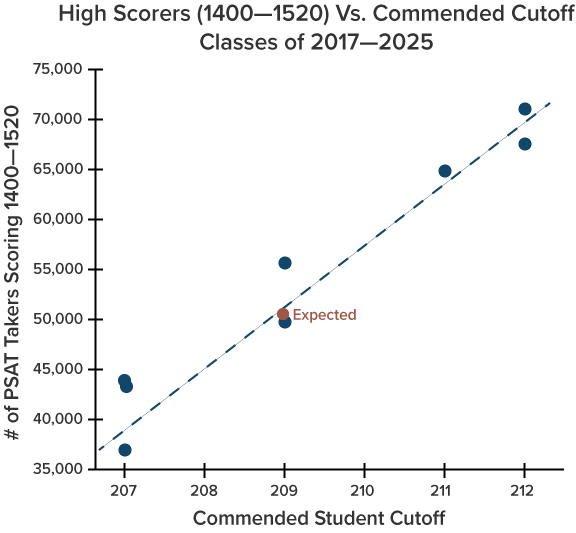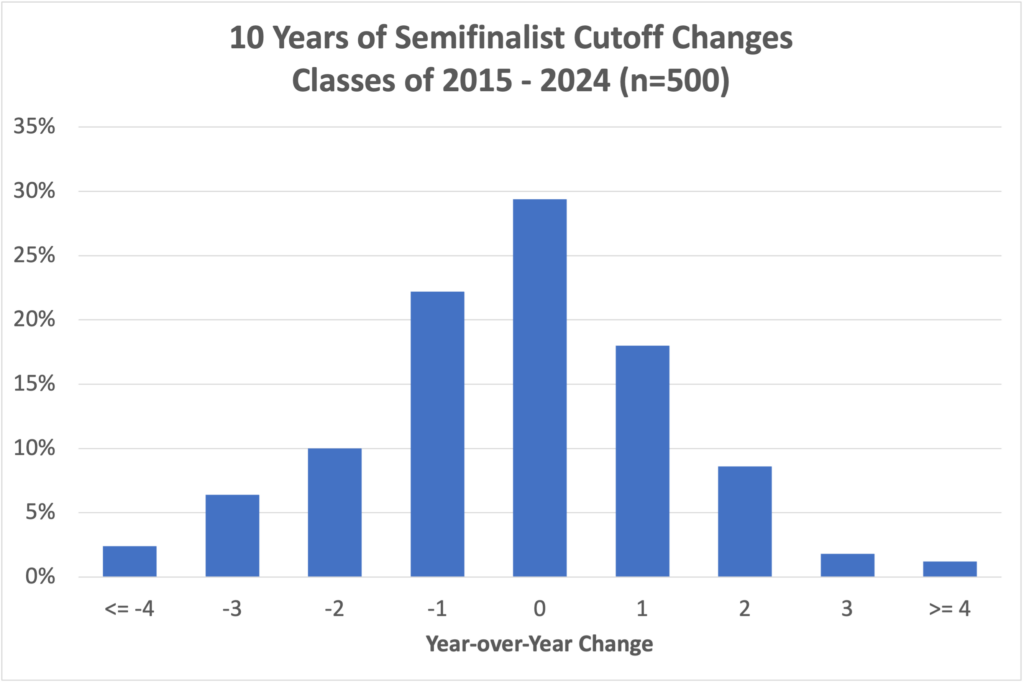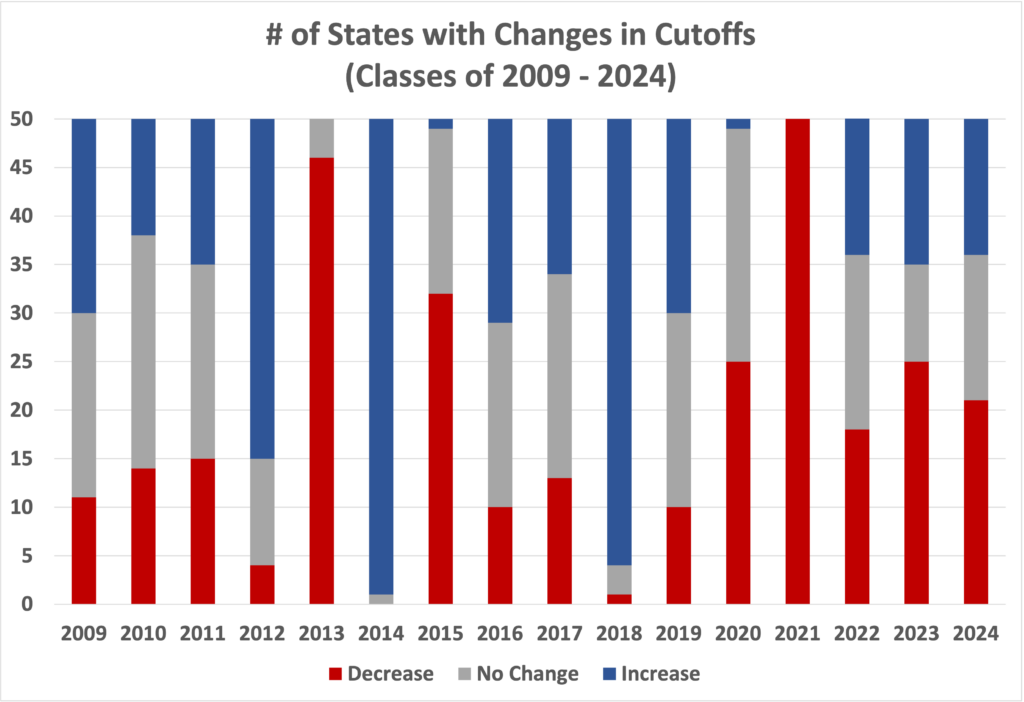
April 8 Update:
The Commended cutoff — the minimum score to be considered for National Merit honors — for the class of 2025 is 208. This is the highest cutoff in 4 years. Compass’s analysis of the results from the first digital PSAT showed that the Commended cutoff would fall in the 208 – 210 range, so the 208 is in line with expectations.
Compass has incorporated the Commended cutoff into its projections for the Semifinalist cutoffs, which will begin filtering out around Labor Day.
Why haven’t I been told anything by my school?
The April announcement is to schools only and is not an official notification of a student’s status. Honored students are not notified until September.
Why aren’t Semifinalist cutoffs announced at the same time?
National Merit must receive student eligibility information from schools and then calculate the separate Semifinalist cutoffs for each state. Only the Commended cutoff is national. NMSC will mail high schools the names of Semifinalists at the end of August, and students will be notified by their schools in early to mid-September. Schools are not given the Commended Student letters until after Semifinalists are announced.
[The November 2023 post below has been updated with the Commended cutoff information.]
The 2023 digital PSAT/NMSQT for the class of 2025 represents the biggest change to the National Merit Scholarship Program since the PSAT was overhauled in 2015. Each year Compass looks at the results from the PSAT and tracks projected Selection Index cutoffs for Commended Students and for Semifinalist in each of the 50 states. [See National Merit Scholarship Program Explained for full details on stages and instructions. For information on the class of 2024 cutoffs, see this archive.]
Instead of having schools administer a paper test on fixed dates, College Board allowed the digital PSAT to be offered throughout October. College Board also introduced a new score return policy. Students taking the test on or before October 14th receive scores on November 6th. Students taking the PSAT after October 14th receive their scores on November 16th. Compass now has the data from both release windows. Approximately 50,000 students landed in the 1400-1520 score band from almost 1.5 million test takers. The initial half of scores already accounted for 30,000 of top band scores, so the later testers had a lower proportion of high scorers. This will come as a relief to students who were fearing an extremely large jump in Selection Index cutoffs.
This year is shaping up similar to the class of 2021 (the last pre-pandemic PSAT) and, reaching back farther, the class of 2017.
The number of top scorers is the most critical piece of information that we get this early in the process. There is a strong correlation between the 1400-1520 band of students and the Commended Student score.
[We now know the exact Commended cutoff is 208. -Ed.] The Commended Student cutoff is likely to rise to 209 (above the 207 from the last 3 years). Estimates can be imperfect, but we are confident that the Commended cutoff will fall within the 208 to 210 range. The higher Commended cutoff, in turn, correlates with higher Semifinalist cutoffs. Below are those estimates.
| State | Class of 2025 (Most Likely) | Class of 2025 (Est Range) | Class of 2024 (Actual) | Class of 2023 (Actual) | Class of 2022 (Actual) |
|---|---|---|---|---|---|
| Alabama | 212 | 210 - 216 | 210 | 212 | 212 |
| Alaska | 212 | 209 - 215 | 209 | 210 | 208 |
| Arizona | 217 | 214 - 220 | 216 | 214 | 218 |
| Arkansas | 212 | 209 - 215 | 210 | 210 | 211 |
| California | 221 | 219 - 223 | 221 | 220 | 221 |
| Colorado | 217 | 215 - 220 | 216 | 217 | 217 |
| Connecticut | 221 | 219 - 222 | 221 | 221 | 220 |
| Delaware | 220 | 218 - 222 | 219 | 218 | 220 |
| District of Columbia | 223 | 222 - 224 | 223 | 223 | 224 |
| Florida | 216 | 215 - 219 | 216 | 216 | 217 |
| Georgia | 219 | 216 - 220 | 217 | 218 | 219 |
| Hawaii | 217 | 215 - 220 | 217 | 215 | 217 |
| Idaho | 214 | 210 - 216 | 211 | 215 | 214 |
| Illinois | 219 | 217 - 221 | 219 | 219 | 218 |
| Indiana | 216 | 213 - 219 | 216 | 214 | 215 |
| Iowa | 213 | 210 - 216 | 210 | 212 | 211 |
| Kansas | 215 | 213 - 218 | 214 | 214 | 215 |
| Kentucky | 214 | 210 - 217 | 211 | 212 | 212 |
| Louisiana | 214 | 211 - 217 | 214 | 213 | 213 |
| Maine | 214 | 211 - 217 | 213 | 215 | 211 |
| Maryland | 222 | 219 - 223 | 221 | 222 | 224 |
| Massachusetts | 222 | 220 - 223 | 222 | 220 | 221 |
| Michigan | 217 | 215 - 220 | 217 | 218 | 217 |
| Minnesota | 218 | 215 - 220 | 216 | 216 | 218 |
| Mississippi | 211 | 209 - 215 | 209 | 210 | 213 |
| Missouri | 215 | 212 - 218 | 214 | 213 | 214 |
| Montana | 210 | 208 - 214 | 209 | 207 | 208 |
| Nebraska | 213 | 209 - 216 | 210 | 212 | 210 |
| Nevada | 214 | 210 - 218 | 211 | 210 | 214 |
| New Hampshire | 215 | 213 - 219 | 215 | 213 | 214 |
| New Jersey | 223 | 222 - 224 | 223 | 223 | 222 |
| New Mexico | 211 | 208 - 214 | 207 | 208 | 210 |
| New York | 220 | 218 - 222 | 220 | 219 | 220 |
| North Carolina | 218 | 215 - 220 | 217 | 217 | 218 |
| North Dakota | 208 | 208 - 210 | 207 | 209 | 207 |
| Ohio | 216 | 214 - 218 | 216 | 216 | 215 |
| Oklahoma | 211 | 209 - 215 | 208 | 211 | 210 |
| Oregon | 217 | 215 - 220 | 216 | 216 | 220 |
| Pennsylvania | 219 | 217 - 221 | 219 | 218 | 218 |
| Rhode Island | 216 | 213 - 219 | 215 | 216 | 213 |
| South Carolina | 213 | 209 - 217 | 209 | 213 | 213 |
| South Dakota | 211 | 208 - 214 | 209 | 212 | 210 |
| Tennessee | 216 | 214 - 219 | 217 | 215 | 215 |
| Texas | 220 | 218 - 221 | 219 | 219 | 220 |
| Utah | 212 | 209 - 216 | 209 | 211 | 212 |
| Vermont | 213 | 210 - 217 | 212 | 213 | 211 |
| Virginia | 221 | 219 - 222 | 219 | 221 | 221 |
| Washington | 220 | 218 - 222 | 220 | 220 | 220 |
| West Virginia | 208 | 208 - 210 | 207 | 207 | 207 |
| Wisconsin | 214 | 212 - 217 | 213 | 213 | 214 |
| Wyoming | 208 | 208 - 210 | 207 | 207 | 208 |
| U.S. Territories | 208 | 208 | 207 | 207 | 207 |
| Studying Abroad | 223 | 222 - 224 | 223 | 223 | 224 |
| Commended | 208 | 208 | 207 | 207 | 207 |
[See Compass’s National Merit Historical Cutoffs post for data going back to the class of 2008, which can be helpful in comparing this year to its analogues.]
The shift to a shorter, online and adaptive exam is unlikely to wreak the havoc we saw when the “revised PSAT” was introduced 8 years ago. That test overhauled content AND scoring. The digital SAT represents a content change — mainly on Reading and Writing — but keeps the 320-1520 score range intact. The Selection Index, too, remains consistent, with the Reading and Writing score having twice the weight of the Math score.
However, for any given state, a change in cutoff is more likely than not. Historically, Semifinalist cutoffs remain unchanged only about one-third of the time.
Even in years where the Commended cutoff remains static, we see half of state cutoffs go up or down. And it is extremely improbable that the Selection Index will be static. The chart below divides the 50 states into those that saw increases (blue), those that remained unchanged (gray), and those that saw declines (red). We are likely to see a year with far more blue than gray and more gray than red.
Uncertainty around exactly which state cutoffs will change and by how much is why we encourage students to compare their scores to the full estimated range in the table above rather than to a single value (our “Most Likely”). These estimates are built from prior performance data and from data on what scores are doing nationally. State and national numbers are not always in alignment. Cutoffs are particularly bumpy in states with smaller pools of test takers and National Merit Semifinalists. Over the last 10 years, large states’ cutoffs have remained within 1 point of the prior cutoff 88% of the time. That figure drops to 73% for midsized states and 53% for small states. No large state’s cutoff has jumped by more than 3 points in a year, whereas 6-point changes have occurred in the pool of smaller states. Scores also tend to be more stable as they get higher. It is more unusual for a state to move from 221 to 222, for example, than for a state to move from 212 to 213.
What does a cutoff mean? Do I need to score at the cutoff or above it?
Students must have a Selection Index at or above the official cutoff in order to qualify for National Merit honors.
The top 52,000 to 54,000 students will receive some form of honors. National Merit Scholarship Corporation (NMSC) determines the cutoff number that comes closest to producing the target number of national honorees. This is the Commended cutoff.
How are Semifinalist cutoffs set?
Unlike the national Commended cutoff, Semifinalist cutoffs are calculated state by state. NMSC allocates the 16,000 semifinalists among states based on the annual number of high school graduates. For example, California sees about 2,000 Semifinalists every year, Michigan 500, and Wyoming 25. In each state, NMSC determines the Selection Index that comes closest to matching its target number of Semifinalists. If 1,900 California students score 222 and higher and 2,050 score 221 or higher, then the Semifinalist cutoff would be 221 (this assumes that the target is exactly 2,000). Because score levels can get crowded, it is easy for cutoffs to move up or down a point even when there is minimal change in testing behavior or performance.
No Semifinalist cutoff can be lower than the national Commended level. Cutoffs for the District of Columbia and for U.S. students studying abroad are set at the highest state cutoff (typically New Jersey). The cutoff for students in U.S. territories and possessions falls at the Commended level each year. Boarding schools are grouped by region. The cutoff for a given region is the highest state cutoff within the region.
Why does the number of top scorers vary from year to year?
While there are changes in the number of students taking the PSAT/NMSQT, there can also be small flaws in test scaling that play a role. Prior to the digital PSAT, a single test form was seen by a large percentage of test takers. Something amiss with that single form could impact selection cutoffs across the country. The digital PSAT is constructed differently. Students receive unique form codes drawn from a large pool of problems. Scaled scores are generated based on the characteristics of those problems. In theory, this should make scores more stable. College Board’s early studies have found an extremely high correlation between the paper-and-pencil test and digital test. Still, even with its adaptive nature, the uncertainty remains as to whether the much shorter test can reliably score students at the 700-760 end of the scale. It appears that the class of 2025 is roughly average compared to the classes of 2017 to 2024 (the years after the change from the 2400 to 1520 scale).
Will test cancellations raise or lower qualifying scores for the National Merit Scholarship Program?
College Board’s online systems failed under load on one of the biggest testing days. There was also a bug that prevented iPads on the latest operating system from submitting exams. We do not know how many schools or students simply gave up and did not retest on rescheduled dates. If the cancellations increase the number of students pursuing alternate entry (see Compass’s explanation of National Merit alternate entry) then cutoffs could rise. Alternate entrants tend to have higher scores, because they can submit SAT scores through June 2024 to enter the competition. They must apply by April.
When are National Merit Semifinalists announced?
The Commended cutoff becomes unofficially known by the end of April. The lists of Semifinalists are not distributed to high schools until the end of August. NMSC sets a press embargo on Semifinalist announcement until mid-September, but schools are allowed to notify students before that date. NMSC does not send Commended Student letters to high schools until mid-September. Compass will keep students updated on developments as those dates approach.
Do state and national percentiles indicate whether I will be a National Merit Semifinalist?
No! Approximately 1% of test takers qualify as Semifinalists each year, so it is tempting to view a 99th percentile score as indicating a high enough score — especially now that College Board provides students with percentiles by state. There are any number of flaws that rule out using percentiles as a quick way of determining National Merit status.
- Percentiles are based on section scores or total score, not Selection Index
- Percentiles are rounded. There is a large difference, from a National Merit perspective, between the top 0.51% and the top 1.49%
- Percentiles reveal the percentage of students at or below a certain score, but the “at” part is important when NMSC is determining cutoffs.
- The number of Semifinalists is based on the number of high school graduates in a state, not the number of PSAT takers. Percentiles are based on PSAT takers. States have widely varying participation rates.
- Most definitive of all: Percentiles do not reflect the current year’s scores! They are based on the prior 3 years’ performance. They are set even before the test is given. And if you are going to use prior history, why not use the completely accurate record of prior National Merit cutoffs rather than the highly suspect percentiles?
Entry requirements for National Merit versus qualifying for National Merit.
Your PSAT/NMSQT score report tells you whether you meet the eligibility requirements for the NMSP. In general, juniors taking the October PSAT are eligible. If you have an asterisk next to your Selection Index, it means that your answers to the entrance questions have made you ineligible. Your answers are conveniently noted on your score report. If you think there is an error, you will also find instructions on how to contact NMSC. Meeting the eligibility requirements simply means that your score will be considered. Approximately 1.4 million students enter the competition each year. Only about 52,000 students will be named as Commended Students, Semifinalists, Finalists, or Scholars. See National Merit Explained for more information.





Hello! I just received a 215 selection index for Tennessee. Do you know anything about how TN fluctuates and the likelihood of it staying at 215? Thank you!
Cole,
Tennessee has stayed at 215 the last two years, but it hadn’t been that low since the class of 2013. Even in what I consider one of the “low years,” TN had a 218 cutoff. I still like 215 as the “most likely” result.
My son has a 213 in Missouri. It is a long wait until September.
Pam,
I wish I could make it shorter. Let’s hope that Missouri stays right where it is.
Hi Art, Many thanks for the information. My son got an index of 217 in Colorado. Could you comment on Colorado’s data? What are the chances that my son can be a semi finalist? Can you explain how you conclude that this is a “low year”? Much appreciated.
Jen,
The fact that we are under 45,000 students scoring 1400-1520 — only 3% of all test takers — aligns with what we have seen historically in years where NMSF cutoffs are considerably lower than in “high years,” where over 60,000 students scored 1400-1520. That information doesn’t tell us what is happening in every state, but it does make me conclude that few states will see large increases in cutoffs this year. Colorado is an example of where the cutoff has been 217 and 218 in low years and 220 and 221 in high years. Because (a) I may be wrong and (b) states can move independently, I’d put a 218 in the 50-75% range.
Thank you for the information! My son received a 220 in California, any thoughts on that, thanks!
Alex,
I think there is a 50/50 chance between 220 and 221 this year. If we assume that CA continues to see lower testing numbers, that probably tips in favor of 220.
Is there any chance that CA will drop to 219? I scored solid 1460/220 twice on practice tests but ended up with a 1450/219. I’m pretty sure it’s unlikely to drop, but my school has apparently had lower PSATs than in previous years, so I’m a little hopeful but doubt it will actually happen.
Leela,
California students are not testing with the same frequency as in the past, so I think a further drop is possible. I’d say 25% chance, but that’s just a modestly informed guess.
My son got a 222 in NJ. Is there any possibility of NJ going back 1 point from last year’s cutoff of 223?
Thank you for your great work.
Samu,
Yes, NJ can be very dependent on test scaling. It doesn’t take many wrong answers at all to fall below 223, depending on the form. Over the last decade, NJ has bounced around between 222 and 223.
Great article. One question – why is the cutoff for “students studying abroad” set to the highest cutoff of all the states. The cutoff of each selection group should be based on the performance of that group as is the case for each of the states. My child is in this bucket and has a score of 216 and it seems quite unfair that her group is set to a different standard than the states. It would be great of you could explain the reasoning behind this.
Mike,
If National Merit allowed the Abroad unit to float independently, the cutoff might even be higher. Think of the U.S. Students Abroad as a very small state with a very elite profile.
How are we assuming that the abroad group gets higher scores? These students are studying curriculums which are quite different from the schools in USA. And hence their range of scores are likely to be significantly different (both highs, lows and medians) from the USA states group. They should therefore be in their own group dont you think? Not sure why this will be a very elite profile.
Mike,
I shouldn’t have made that assumption. Unfortunately, NMSC has been handling the U.S. Students Abroad in the same way for decades.
Robert, great site. So helpful! My child in MA scored a 222 for the 10/2022 test. Based on your calculations, it would seem that there is something close to a 95 pct probability that this is enough for a semifinalist, I.e. very, very unlikely that MA jumps 3 points yoy to 223 for its cutoff. . Any thoughts? Thanks in advance.
D
David,
I might put it at more like 90%, but we’re guessing at that stage. The cutoff has been 223 in 2 of the last 5 years, but those were pre-pandemic cutoffs and in years where we had a LOT more high scorers. You’re right that a 3-point jump in a high-scoring state is rare.
Many thanks!
Thoughts on Mississippi? Daughter has a 212, It seems as though Mississippi has had small fluctuations over the last few years. Reviewing your information, I don’t see any increase of over two points for any given years–fingers crossed.
Eree,
Mississippi has moved around more than most states because of its size. What was unusual in the class of 2022, for example, was that it was a full 6 points above the Commended level. You are correct, though, that MS has not jumped up more than 2 points in the 15 years for which we have data. The 210 of last year is the lowest in a dozen years. I think 212 falls in the 50-75% range.
Hello Art,
My name is Matthew and i’m from michigan. I got 218 selection index. What are my chances?
Matthew,
I like your chances. Michigan has seen 219 cutoffs, but those were in years where we saw large numbers of high scorers nationwide.
I got a 219 in TX. I’m worried i may not make the cutoff. what are my chances?
Arun,
About even or just above. In the 4 years that I consider low years, Texas has had 2 cutoffs of 219 and 2 of 220. This year looks similar to last, which would be a good sign.
I know this probably won’t cut it for commended, but my class of 24 daughter was in the 97th percentile overall this year with a 204. Scores might be low this year.
KJ,
The percentiles from College Board are based on the classes of 2021, 2022, and 2023, so they don’t, unfortunately, tell us about how students did this year. I appreciate the information!
Oh no – my son received a 219 in CT, however there’s an * by his score that said he left some of the entry requirement info blank on his score sheet? Is he out of luck, or is that something that can be corrected in order to be eligible?
There is not an immediate rush, but you may want to contact NMSC or check with his college counselor. Many times the problem is that College Board doesn’t have the class year.
Hello, I recently got a 214 in Tennessee, do you think this will be good enough for semifinalist. I know that it is pretty unlikely, but I just want some peace of mind.
Shawn,
It depends on what you consider peace of mind. A 1-point drop is hardly out of the question. You will at least make Commended.
Thank you so much for this information–it’s very helpful! (My son just learned he got a 217, and we are in Arkansas.)
Brian,
Thank you. Congratulations to your son! He will be a Semifinalist.
Hello Art,
Thanks for such a comprehensive analysis.
My kid got 223 in NJ. My question is why there is a long wait until next September , 2023 to reveal NMSF while all scores were known in December, 2022 ?
Robert,
I often ask the same question. First, not all of the scores are known. Scores continue to dribble in as College Board makes corrections or students fix incorrect class years. Also, students who missed the PSAT can enter the competition via Alternate Entry. The biggest factor, though, is logistical. NMSC needs to verify everything with high schools. It’s tough for them to do that right away because NMSC is busy figuring out Finalists and then making matches with colleges and scholarships. They don’t contact high schools until around April. By the time it has the information it needs, it is summer, and NMSC waits until school is back in session. It’s an antiquated system that hasn’t changed in 60 years.
I think there is very little chance we will see a 224 from NJ. We have still never seen a truly organic 224. Maryland’s in the class of 2022 was the result of the pandemic and the influx of Alternate Entrants.
I got a 206 index in Mississippi, any chance of making it?
Harry,
A 206 is possible for Commended, but Mississippi’s Semifinalist cutoff will be higher than that.
Thank you Art for a great article. What are your thoughts on the chances Texas goes above 221? My child received a 221, and like many others, it will be a long wait until September!
Daniel,
I don’t know if there is a zero chance, but it’s VERY near zero. Texas has never had a 222, and I don’t see a reason why it would start this year.
What is the state or selection unit for an online student who resides in a different state than the online school’s corporate offices? Also, what has been the highest Selection Index needed to qualify for Semifinalist under the current PSAT? What do you think will be the highest Selection Index this year?
Parent,
I haven’t dealt with that situation before. It may be the physical location where the student took the test, but I am unsure. You might want to contact NMSC for guidance. The highest Selection Index is likely to be 222 or 223 this year.
Great idea! NMSC says that virtual students are treated as homeschool students. Thank you for your help!
Thank you!
My son scored a 220 in Texas. Do you think there is a high chance to qualify as a semifinalist? He already took the SAT last summer and received a 1510. Will this be high enough for further National Merit considerations or should he take the SAT again?
Jack,
I think there is a good chance that he will qualify in Texas. There is only an outside chance of a 221. His 1510 is more than enough to serve as a “confirming” score for Finalist consideration. It’s not a situation where a higher score help him.
My son just moved from TX to MD this August and took the PSAT in MD. Unfortunately, he got 220 which might be in the gap between TX and MD. He is very frustrated with this result. Is there anything we can do and what is his chance of NMSC in a “low year”?
Ray,
Since he took the test in MD, his success is tied to Maryland’s cutoff. There is at least a small chance that Maryland could drop 2 points. It’s a highly competitive state, I’m afraid. There is nothing more to be done at this point beyond wait.
Hi,
My son has an index of 216 in Nebraska. What are the chances he will receive semifinalist standing?
Pamela
Pamela,
Congratulations! Your son will be a Semifinalist.
Thanks for this information. Do you think MN will be a low year?
Marie,
I have only seen College Board data at the national level. Individual states do not always follow that trend. All we can say is more will be low than high.
Thank you so much for this article! It helped explain so much! My son got a 221 in Georgia, so here’s to hoping we don’t have an unusually high spike for our state!
Kim,
Fingers crossed. A 221 would be a record high for Georgia, and I just don’t see that happening. Your son is in great shape.
Art,
My son has taken both the PSAT and SAT – this year (HS’24). Seemingly his qualifying score is higher from his SAT (226) than his PSAT (220)? Question: Can he substitute his PSAT score with his SAT score for purposes of NMSSF consideration?
Thanks
Brian,
Students who have taken the PSAT can not use the SAT for consideration.
Can you please help me interpret my daughter’s NMSQT score of 223 in Connecticut
Thank you for all the great information on this site
Hareesh,
With a 223 Selection Index, your daughter will qualify as a Semifinalist in CT. This will allow her to continue on in the competition for spots as Finalist and Scholar.